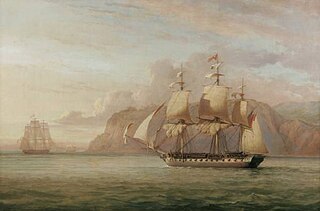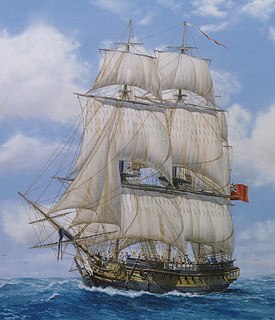Ten ships of the Royal Navy have been named HMS Hussar, after the hussar.
Ten ships of the Royal Navy have been called HMS Aurora or HMS Aurore, after the Roman Goddess of the dawn.
Many ships of the Royal Navy have been named HMS Garland. The name dates back to 1242, being the oldest confirmed ship name in the Royal Navy.
Sixteen ships of the Royal Navy have been named HMS Lively. Another was planned, but renamed before being launched:

HMS Majestic was a 74-gun third-rate ship of the line launched on 11 December 1785 at Deptford. She fought at the Battle of the Nile, where she engaged the French ships Tonnant and Heureux, helping to force their surrenders. She was captained by George Blagdon Westcott, who was killed in the battle.

Eighteen ships of the Royal Navy have borne the name HMS Mercury, or HMS Mercure, after the God Mercury, of Roman mythology:
Thirteen ships of the Royal Navy have borne the name HMS Experiment:

Proserpine was a 38-gun Hébé-class frigate of the French Navy launched in 1785 that HMS Dryad captured on 13 June 1796. The Admiralty commissioned Proserpine into the Royal Navy as the fifth rate, HMS Amelia. She spent 20 years in the Royal Navy, participating in numerous actions in the French Revolutionary and Napoleonic Wars, capturing a number of prizes, and serving on anti-smuggling and anti-slavery patrols. Her most notable action was her intense and bloody, but inconclusive, fight in 1813 with the French frigate Aréthuse. Amelia was broken up in December 1816.

HMS Dryad was a fifth-rate sailing frigate of the Royal Navy that served for 64 years, at first during the Napoleonic Wars and then in the suppression of slavery. She fought in a notable single-ship action in 1805 when she captured the French frigate Proserpine, an action that would later earn her crew the Naval General Service Medal. Dryad was broken up at Portsmouth in 1860.

HMS Melampus was a Royal Navy fifth-rate frigate that served during the French Revolutionary and Napoleonic Wars. She captured numerous prizes before the British sold her to the Royal Netherlands Navy in 1815. With the Dutch, she participated in a major action at Algiers and, then, in a number of colonial punitive expeditions in the Dutch East Indies.

HMS Argo was a 44-gun fifth-rate Roebuck-class ship of the Royal Navy. She was launched in 1781 from Howdon Dock. The French captured her in 1783, but 36 hours later the British recaptured her. She then distinguished herself in the French Revolutionary Wars by capturing several prizes, though she did not participate in any major actions. She also served in the Napoleonic Wars. She was sold in 1816.

HMS Decade was a 36-gun fifth-rate frigate of the Royal Navy. She was formerly the French ' Galathée-class frigateDécade, which the British had captured in 1798. She served with the British during the French Revolutionary and Napoleonic Wars, and was sold out of the service in 1811.

HMS Santa Dorothea was a Royal Navy 34-gun fifth rate. This frigate had previously served in the Spanish Navy under the name Santa Dorotea. Built in Spain in 1775, she served during the early years of the French Revolutionary Wars until being captured while sailing as part of a squadron off Cartagena. Taken into British service, she spent the rest of the French Revolutionary and most of the Napoleonic Wars under the white ensign, until being broken up in 1814.

HMS Proserpine was a 28-gun Enterprise-class sixth-rate frigate of the Royal Navy. She was launched in 1777 was wrecked in February 1799.

HMS Venus was the name ship of the 36-gun Venus-class fifth-rate frigates of the Royal Navy. She was launched in 1758 and served for more than half a century until 1809. She was reduced from 36 to 32 guns in 1792. She was sold in 1822.

Vice-Admiral Alexander Fraser RN (1747–1829) was a late 18th century and early 19th century Royal Navy commander during the Napoleonic Wars. He was responsible for the landing parties in the Battle of Long Island, captured several privateers and took place in the Second Battle of Copenhagen.











